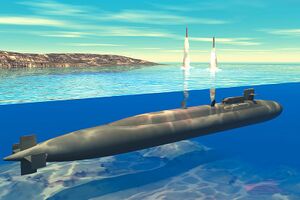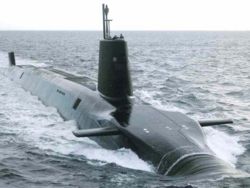Difference between revisions of "Submarine"
(→See also) |
(A German submarine ("U-boat" U-20) torpedoed and sunk a passenger British cruise liner on May 7, 1915, as it traveled across the Atlantic Ocean from New York City to Liverpool, England, killing 1,195 (including 123 Americans) of the 1,) |
||
| (20 intermediate revisions by one other user not shown) | |||
| Line 1: | Line 1: | ||
[[Image:Typhoon3.jpg|right|thumb|250px|A typhoon class nuclear ballistic missile submarine.]] | [[Image:Typhoon3.jpg|right|thumb|250px|A typhoon class nuclear ballistic missile submarine.]] | ||
A '''submarine''' is a vehicle that travels under water (i.e. an underwater boat). The submarine was invented in the 17th century. Though it was originally designed for the purpose of exploration, its military benefits soon became clear. The first military submarine was the Turtle which was used by the Colonists during the [[American Revolution]], although without success. | A '''submarine''' is a vehicle that travels under water (i.e. an underwater boat). The submarine was invented in the 17th century. Though it was originally designed for the purpose of exploration, its military benefits soon became clear. The first military submarine was the Turtle which was used by the Colonists during the [[American Revolution]], although without success. | ||
| + | |||
| + | A [[German]] submarine ("U-boat" U-20) torpedoed and sunk a passenger British cruise liner on May 7, 1915, as it traveled across the [[Atlantic Ocean]] from [[New York City]] to [[Liverpool]], [[England]], killing 1,195 (including 123 Americans) of the 1,959 men, women, and children who were on board.<ref>https://www.loc.gov/collections/world-war-i-rotogravures/articles-and-essays/the-lusitania-disaster/#:~:text=On%20May%207%2C%201915%2C%20the,1%2C195%20perished%2C%20including%20123%20Americans.</ref> | ||
==History== | ==History== | ||
| Line 8: | Line 10: | ||
Submarines played a significant role in both World Wars I and II, and to this day many nations have submarine fleets, varying from the large, highly trained nuclear fleets of the United States and the United Kingdom, to countries owning one Kilo class diesel submarine. | Submarines played a significant role in both World Wars I and II, and to this day many nations have submarine fleets, varying from the large, highly trained nuclear fleets of the United States and the United Kingdom, to countries owning one Kilo class diesel submarine. | ||
| + | [[File:Virginia class submarine.jpg|thumbnail|300px|center|In the United States, the submarine force is often referred “The Silent Service” because of how it operates. Submarines can submerge more than 600 feet below the ocean's surface for up to four months at a time, constantly patrolling and working classified missions.<ref>[https://www.uso.org/stories/3060-what-you-should-know-about-the-u-s-naval-submarine-force What You Should Know About the U.S. Naval Submarine Force], United Service Organizations (OSO) website</ref> ]] | ||
| + | {{clear}} | ||
| + | [[File:794px-Defense.gov News Photo 960703-N-00000-001.jpg|thumbnail|300px|center|The United States' newest and most advanced attack submarine Seawolf represents the U.S. Navy's most advanced quieting technology, weaponry, tactical capability and communications. | ||
| + | <br /> | ||
| + | <br /> | ||
| + | Seawolf class submarines have eight torpedo tubes and can hold up to 50 weapons in its torpedo room.]] | ||
| + | {{clear}} | ||
==Power sources== | ==Power sources== | ||
| Line 20: | Line 29: | ||
*SSBN is Ship, Submersible, Ballistic (missile), Nuclear (powered) | *SSBN is Ship, Submersible, Ballistic (missile), Nuclear (powered) | ||
*SSGN is Ship, Submersible, Guided (missile), Nuclear (powered) | *SSGN is Ship, Submersible, Guided (missile), Nuclear (powered) | ||
| − | + | [[Image:submarine.jpg|250px|thumb]] | |
The "N" refers to nuclear propulsion, not necessarily nuclear weapons. An SSBN is capable of being armed with nuclear missiles while an SSGN is designed to carry up to 154 Tomahawk cruise missiles. SSN's are capable of carrying Tomahawks, but only a very limited number of tubes. The SSGN has 8 tubes that can be reconfigured to support Special Operations Forces in a variety of roles. | The "N" refers to nuclear propulsion, not necessarily nuclear weapons. An SSBN is capable of being armed with nuclear missiles while an SSGN is designed to carry up to 154 Tomahawk cruise missiles. SSN's are capable of carrying Tomahawks, but only a very limited number of tubes. The SSGN has 8 tubes that can be reconfigured to support Special Operations Forces in a variety of roles. | ||
| Line 32: | Line 41: | ||
*Guam | *Guam | ||
*At least for the meantime there is a submarine tender at the NSA (naval support activity) located in LaMadalena, Italy. An island off the coast of Sardinia. | *At least for the meantime there is a submarine tender at the NSA (naval support activity) located in LaMadalena, Italy. An island off the coast of Sardinia. | ||
| − | [[ | + | |
| + | === Ohio-class submarine === | ||
| + | |||
| + | [[File:800px-Good Luck Ohio.jpg|thumbnail|center|300px|The Ohio class of nuclear-powered submarines includes the U.S. Navy's 14 ballistic missile submarines and its four cruise missile submarines. ]] | ||
| + | {{Clear}} | ||
| + | [[File:800px-Ohio-class submarine launches Tomahawk Cruise missiles (artist concept).jpg|thumbnail|center|300px|Artist's rendition of an Ohio-class nuclear-powered submarine launching Tomahawk Land Attack Missiles. | ||
| + | <br /> | ||
| + | <br /> | ||
| + | According to the National Interest website: "The Ohio-class boats may be the most destructive weapon system created by humankind. Each of the 170-meter-long vessels can carry twenty-four Trident II submarine-launched ballistic missiles (SLBMs) which can be fired from underwater to strike at targets more than seven thousand miles away depending on the load."<ref>[https://nationalinterest.org/blog/the-buzz/attack-just-one-these-us-nuclear-submarines-would-destroy-23359 An Attack from Just One of These U.S. Nuclear Submarines Would Destroy North Korea], National Interest website, 2017</ref>]] | ||
| + | {{Clear}} | ||
== See also == | == See also == | ||
* [[Naval warfare]] | * [[Naval warfare]] | ||
* [[United States Navy]] | * [[United States Navy]] | ||
| − | |||
* [[Destroyer]] | * [[Destroyer]] | ||
* [[AE2]] | * [[AE2]] | ||
Latest revision as of 02:41, June 26, 2023
A submarine is a vehicle that travels under water (i.e. an underwater boat). The submarine was invented in the 17th century. Though it was originally designed for the purpose of exploration, its military benefits soon became clear. The first military submarine was the Turtle which was used by the Colonists during the American Revolution, although without success.
A German submarine ("U-boat" U-20) torpedoed and sunk a passenger British cruise liner on May 7, 1915, as it traveled across the Atlantic Ocean from New York City to Liverpool, England, killing 1,195 (including 123 Americans) of the 1,959 men, women, and children who were on board.[1]
Contents
History
The first submarine to successfully sink a ship was the Confederate vessel CSS Hunley which sank the USS Housatonic during the American Civil War on 17 February 1864 in Charleston Harbour. The Hunley never returned from the mission, sinking with the loss of all crew. It has recently been found and recovered.
The first submarine commissioned into the United States Navy was the USS Holland. She was commissioned on Columbus Day in 1900 and was subsequently designated SS 1.
Submarines played a significant role in both World Wars I and II, and to this day many nations have submarine fleets, varying from the large, highly trained nuclear fleets of the United States and the United Kingdom, to countries owning one Kilo class diesel submarine.

Power sources
Various different power sources have been used on submarines over the years. The Hunley was powered by its crew turning a crank which was connected to the propeller. Petrol engines have also been used, but they gave way to diesel engines. The petrol or diesel engine drives a generator, which charges a battery, and the battery supplies an electric motor which propels the submarine. The petrol or diesel engine can only be run when the submarine is on the surface, to recharge the battery.
Hydrogen peroxide was used in some German submarines during World War II. More recently nuclear power has been used. It should be noted it this context that the term "nuclear submarine" refers to a submarine that uses nuclear power for propulsion, not necessarily one which carries nuclear weapons.
Today, the United States Navy operates 14 Ohio class SSBN's, 4 Ohio class SSGN's, 3 Seawolf class SSN's, approximately 40 Los Angeles Class SSN's, and 2 commissioned Virginia class SSN's.
- SSN is Ship, Submersible, Nuclear (powered)
- SSBN is Ship, Submersible, Ballistic (missile), Nuclear (powered)
- SSGN is Ship, Submersible, Guided (missile), Nuclear (powered)
The "N" refers to nuclear propulsion, not necessarily nuclear weapons. An SSBN is capable of being armed with nuclear missiles while an SSGN is designed to carry up to 154 Tomahawk cruise missiles. SSN's are capable of carrying Tomahawks, but only a very limited number of tubes. The SSGN has 8 tubes that can be reconfigured to support Special Operations Forces in a variety of roles.
Currently, the United States Navy maintains submarines bases in:
- Groton, CT
- Norfolk, VA
- Kingsbay, GA
- Banger, WA
- San Diego, CA
- Pearl Harbor, HA
- Guam
- At least for the meantime there is a submarine tender at the NSA (naval support activity) located in LaMadalena, Italy. An island off the coast of Sardinia.
Ohio-class submarine

According to the National Interest website: "The Ohio-class boats may be the most destructive weapon system created by humankind. Each of the 170-meter-long vessels can carry twenty-four Trident II submarine-launched ballistic missiles (SLBMs) which can be fired from underwater to strike at targets more than seven thousand miles away depending on the load."[3]
See also
External links
- The Silent Service (in color) - U.S. Navy WWII (video - The Story of U.S. Submarine Warfare in the Pacific During WWII)



